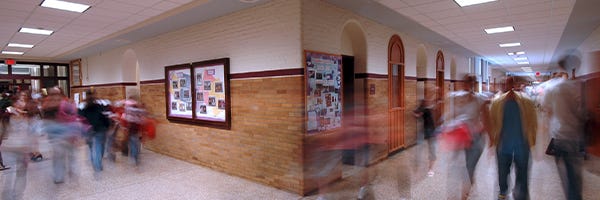Keep students and staff safe at school
- May 24, 2021
- 0 Comments


Keep Students and Staff Safe at School
Students are currently going to school in a variety of settings, whether that is at home, in person, or a mix of both. However, as districts slowly welcome their students back to full in-person learning, it is important that schools are adequately prepared to keep their students safe in case of an emergency.
Traumatic Bleeding and Stop the Bleed
From 2013 to 2019, there were 549 incidents of gunfire on school grounds. Unfortunately, this number shows how important it is for districts to be prepared in case of a tragic event. In general, uncontrolled bleeding is the leading cause of preventable death in trauma patients. Providing students and staff with the proper training to respond to these situations is key not only for incidents involving gunfire, but also for other instances where traumatic bleeding can occur. The American College of Surgeons’ Stop the Bleed program is a great initiative that trains people on what to do in case of an emergency. You can shop Stop the Bleed kits, tourniquets, and more here.
Cardiac Arrest
According to the American Heart Association, cardiac arrest occurs in about 7,000 children outside of the hospital each year. This, coupled with new COVID-19 research showing that the virus has the potential to affect the heart, means that schools need to be prepared with the proper equipment in case of a cardiac emergency. As schools open, it is imperative that they check their AEDs and AED accessories for signs of wear.
- Verify that AED batteries are working and have not expired.
- Check the service indicator light.
- Check for any wear and tear on the AED.
- Ensure that AED pads and accessories are not expired.
- Consider adding additional AEDs and signage in high traffic areas such as hallways, main building entrances, gymnasiums, cafeterias, auditoriums, and nurse’s office.
Fire Prevention, Burn Treatment, and Weather Emergencies
The National Fire Protection Association states that from 2014-2018 fire departments responded to an average of 3,230 structure fires in schools per year. The organization also found that school fires mostly started in bathrooms or locker rooms. After being closed throughout much of the last school year, it is imperative that schools check that their fire systems, including fire alarms, fire extinguishers, cooking equipment and water-based protection systems and sprinklers, are still fully functional. When it comes to weather-related emergencies, it is important for schools to have working weather monitors to stay informed on severe weather as well as a well-rehearsed plan of action in case of a tornado, or other event.
In addition, make sure your building has:
- Working exterior lighting with timers or motion sensing capabilities
- Working intrusion alarms, ventilator openings, and roof hatches
- Trees, bushes, and other plant life trimmed to keep areas around the building clear
- Trash receptacles stored away from buildings
- Monthly fire drills with students and staff so that everyone knows all evacuation procedures
- Proper equipment to for fire prevention and fire treatment
- Proper emergency evacuation equipment
School Lockdown
In the United States, firearms are the leading cause of death in children and teens, according to Everytown. The organization also states that so far in 2021, there have been 18 incidents of gunfire on school grounds across the country. In 2020, there were 67 incidents. In light of these numbers, schools need to have a lockdown plan in place, regularly practice lockdown drills with students and staff, and have the necessary lockdown supplies and emergency equipment on hand.
Drug Deactivation
In a 2017 survey from the Substance Abuse and Mental Health Services Administration, 2.2 million adolescents between the ages of 12-17 were illicit drug users. In case of an overdose emergency at school, the National Association of School Nurses states that it is the responsibility of the nurse to respond and give medication like Naloxone, or other drug deactivation assistance, since they would be the first health professional to come in contact with a student experiencing an overdose emergency.
Accidents and Injury
Accidents and injury can happen at any time, so schools need to be prepared with the proper supplies like first aid kits and accessories, including blankets and emergency lighting. Common cause of injuries at school include bullying, slipping and falling, playground accidents, food poisoning, school bus accidents, and sports injuries.
Check your first aid kit for:
- Working flashlights and/or two-way radios with good batteries.
- Check the expiration dates and packaging on any antibiotics or ointments in the kit.
- Replace any supplies in your kit that looks like it has been used up.
It is impossible to predict an emergency, but it is possible to be prepared. By having the proper emergency procedures in place as well as the necessary equipment and supplies, schools can ensure the safety of their staff and students if an emergency occurs.
Visit our School Safety Center to see our full selection of emergency equipment and resources.
Important Links
https://everytownresearch.org/maps/gunfire-on-school-grounds/
https://www.ncbi.nlm.nih.gov/pmc/articles/PMC2887168/
https://everytownresearch.org/report/the-impact-of-gun-violence-on-children-and-teens/
https://www.heart.org/en/news/2018/11/09/defibrillators-may-help-kids-survive-cardiac-arrest
https://www.nasn.org/advocacy/professional-practice-documents/position-statements/ps-naloxone
https://www.usfa.fema.gov/coronavirus/planning_response/covid19_fire_safety_school_reopening.html
https://blog.nationwide.com/school-fire-safety-checklist/
https://www.parkerlawfirm.com/library/common-ways-children-are-injured-in-school-accidents.cfm
https://www.mayoclinic.org/first-aid/first-aid-kits/basics/art-20056673
https://www.weather.gov/grb/schools
